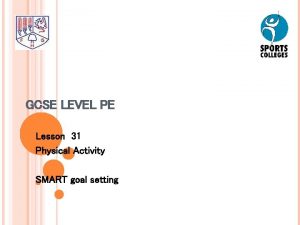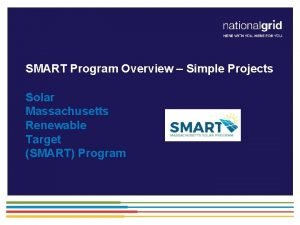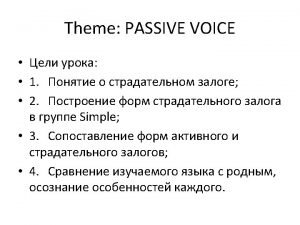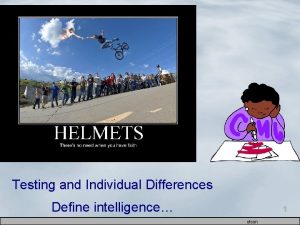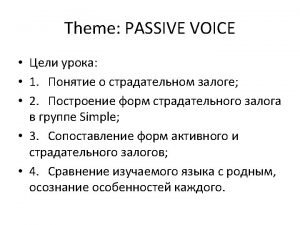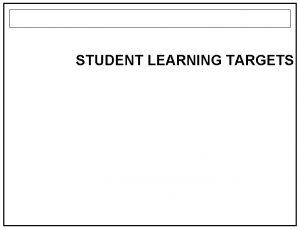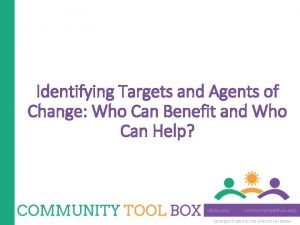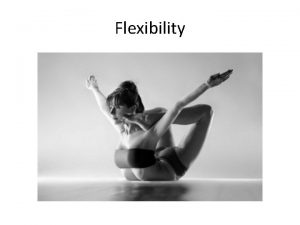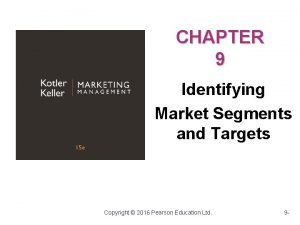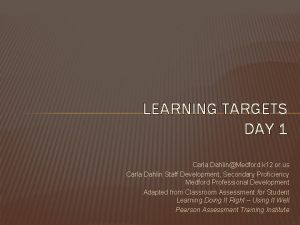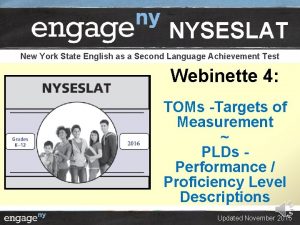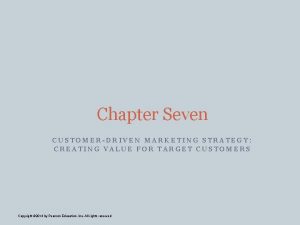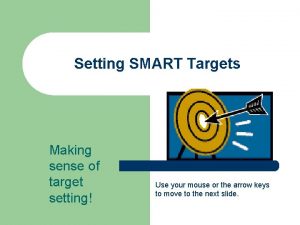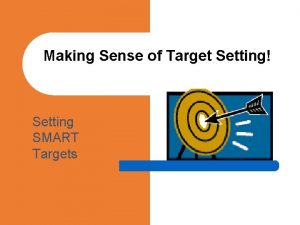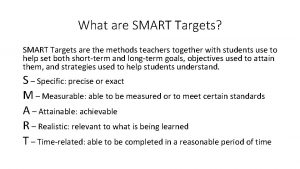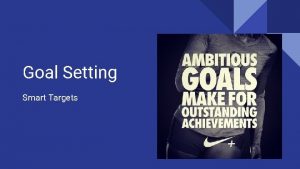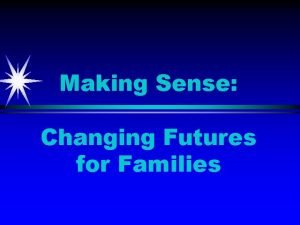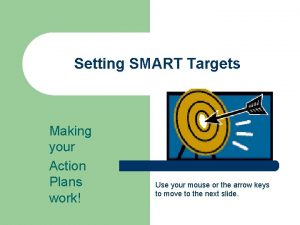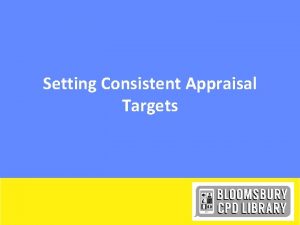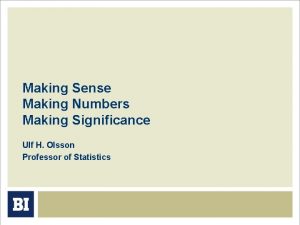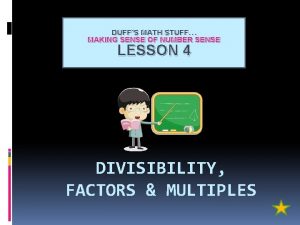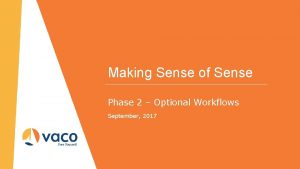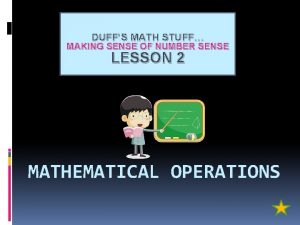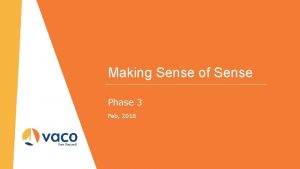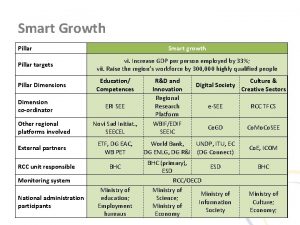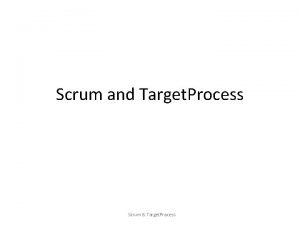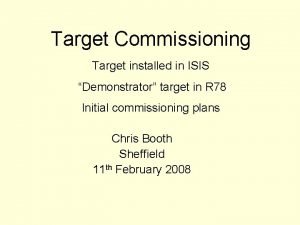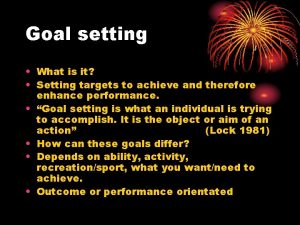Making Sense of Target Setting Setting SMART Targets





































- Slides: 37

Making Sense of Target Setting! Setting SMART Targets

This session will help you to: l l l Decide what you want to accomplish in your studies this year. Understand use the SMART goal technique. Break up your goals into achievable targets. Write a learning plan. Understand how to maintain your Student E-ILP. Achieve the results you desire!

Goal Setting: linked to achievement l l Psychology Today says: Setting goals builds self-confidence and motivation. A 2015 study showed that when people wrote down their goals, they were 33 percent more successful in achieving them than those who formulated outcomes in their heads. https: //www. psychologytoday. com/gb/blog/the-moment-youth/201803/goal-setting-is-linked-higherachievement (Accessed: 30 June 2020)

Goal Setting: a two-step process 1. Decide what you want to accomplish. 2. Devise a learning plan to achieve the result you desire. Use Activity Handout

Activity Handout – Learning Plan

Step one: Decide what you want to accomplish l Set yourself personal learning goals for your course. I’m not sure what my goals are?

What are your goals? Some questions to get you thinking. l What do you think you may find the most difficult about this course? l How is your time keeping & attendance? l Is there anything outside of college that may affect your studies? l Do you have trouble with research and assignments? I want to pass my course. I want to get my GCSE Maths. I want to progress to the next level. Students need to write the answers to these questions on their Activity Handout

What do you want to achieve? l l l A great attendance & punctuality record? To take part in small group activities? To develop my confidence? To improve my spelling? To learn my timetables? I want to develop my professional skills for work placement Students need to write the answers to these questions on their Activity Handout

Students can use these examples on their Activity Handout Some examples: “I want to…” Understand my assignment brief thoroughly – for example what is the marking criteria for a Distinction, Merit, or Pass? Improve my research skills – for example by learning about Google Scholar or using online learning tools such as E-books, or Immersive Reader, Maths. Watch, For. Skills. Improve my essay writing/assignment writing skills – for example by writing paragraphs which accommodate PEEL (Point, Evidence, Explain, Link), or by learning how to Reference correctly. Plan my time – for example by thinking in advance about when I need to start my assignments, or by developing more effective note-taking techniques.

Step one: Decide what you want to accomplish Activity: Decide what you want to accomplish. e. g. to attend all my classes, to have the right equipment for studying, to manage distractions and focus on my work, to develop my essay writing skills. The more benefits you can list for your goals the more motivating those goals will become. Write a list of all the benefits you will obtain if you accomplish the goals. Students need to write the benefits from accomplishing their goals on their Activity Handout

Write down the benefits to you when you obtain your goals Complete your Activity Handout by writing down the priority areas, goals and benefits that are important for you.

Step two: Plan to achieve the results you desire l l We are going to continue the learning plan to help you achieve your priorities and goals Break it down into small achievable targets Keep it simple and realistic Start off small - what can I achieve this week? Today? In the next hour?

First: Understand SMART Targets Good targets need to be: l l l Specific – you, your course Measurable – how you check success Achievable – it can be done Relevant – it is meaningful Timed – by when, what is the deadline

Be SMART

Why? So you can ask yourself the right questions, write your answers down and have an action plan to refer to!

Developing your Learning Plan Complete your Activity Handout by making your goals SMART. Identify the learning resources you might need. Add dates to show when you will accomplish your targets.

S is for Specific “Specific” means that you say what you want to do very precisely. Who: Who is involved? What: What do I want to accomplish? Where: Identify locations. Why: Specific reasons, purposes for accomplishing the goal. Which: Identify requirements and constraints.

Some examples making targets SMART: Get a better grade in my subject ___________ Complete all assignments on time. ___________ Get my qualification. Achieve a Distinction by Easter ___________ Work on assignments each night for 30 minutes. ___________ Attend all lessons, hand in all assignments on time, for the whole academic year.

Some examples making targets SMART: Do better (? – more specific!) Research topics and read over notes. Be more involved ? Join in other college activities.

Specific Targets. . . Example: Create Specifc Targets for Essay Writing l l I will ask my tutor, the LRC, my parents or guardian for help. . . To research how to write a paragraph well using PEEL – Point, Evidence, Explain, Link. I need to be able to complete written assignments whilst I am at college or at home if I am selfisolating. I need to write well to pass my course, which will help me to get a job or study at a higher level. l l Write your goal as a SPECIFIC goal for yourself. E. g. My goal is to write my first assignment using paragraphs that include: PEEL Point, Evidence, Explain. Link

M is for Measurable targets tell you exactly what you need to do in order to succeed by examining the specifics in more detail. “I will ask my Tutor: l For an example of a PEEL paragraph l What online websites they recommend l For guidance on sentence structure l … l l Write your goal as a MEASURABLE target for yourself. E. g. My target is to ask my tutor for an example of PEEL.

A is for Achievable. An achievable target has to be something you can do. “I am going to work on creating one correct PEEL paragraph this week” is probably achievable for most people. l l Write your goal as an ACHIEVABLE target for yourself. E. g. My target is to write one correct PEEL paragraph and ask for my tutor's feedback.

R is for Relevant What I’m going to do needs to help me to get what I want. l By writing a PEEL paragraph I will be able to demonstrate my knowledge about my subject. l Write your goal as a RELEVANT target for yourself. E. g. My PEEL paragraph will be related to my course subject criteria.

T is for Timely If I don’t know how much time I have, I don’t know when to take action. l l Ensure you give yourself a deadline by when the target must be met. Write your goal as a TIMELY target for yourself. E. g. My PEEL paragraph will be written by the end of the week.

Finalising your Learning Plan

So remember. . . Targets must be: l Specific l Measurable l Achievable l Relevant l Time-bound I will try to meet my targets and monitor my progress so I can reach my goal.

E-Individual Learning Plans (ILPs)

E-ILP l l l l Your Individual Learning Plan forms an important part of your course. It records your learning goals. It enables your progress to be measured and evaluated regularly. ILP’s are updated during the year. ILP’s include: Smart targets Action plans Progress reviews

What is the Purpose of a Learning Plan? It identifies the specific learning process you will work through in order to achieve your goals. • • • It helps you to identify the priorities for your development, It records your learning goals and targets, so you can be clear on actions you need to take to develop your ability as an independent learner. It measures your progress so you stay on track to achieve a positive learning outcome. Attendance in class Independent Learning Plan SMART Targets Progress Reviews Coursework and Assignments POSITIVE OUTCOME YES YOU PASSED!

Accessing your E-ILP via webpage Click on Oak. Extra to find the Student ILP link

Accessing your E-ILP via Oak. Extra link in Canvas Can also be accessed Via Canvas, Useful Links, Oak. Extra

Accessing your E-ILP in Oak. Extra Click on the Student ILP link

Student ILP

My Goals

My Targets

Your PDR tutor will be able to help you with different target areas

Good Luck with your Targets! When you use SMART targets, you set yourself up for success! Please can you complete this Feedback Form for Study Skills Session Term 1 a https: //bit. ly/2 Di. NPv. B
 Smart targets gcse pe
Smart targets gcse pe Narrow sense heritability vs broad sense heritability
Narrow sense heritability vs broad sense heritability Narrow sense heritability vs broad sense heritability
Narrow sense heritability vs broad sense heritability Primary target market and secondary target market
Primary target market and secondary target market Making sense of discourse
Making sense of discourse Solar massachusetts renewable target (smart) program
Solar massachusetts renewable target (smart) program Book smarts definition
Book smarts definition One smart man he felt smart
One smart man he felt smart It's not how smart you are
It's not how smart you are Future smart 2 answers
Future smart 2 answers It's not how smart you are
It's not how smart you are Kim ung yong
Kim ung yong Street smart vs book smart quotes
Street smart vs book smart quotes One smart man he felt smart
One smart man he felt smart What are four objectives of warehouse operation?
What are four objectives of warehouse operation? Writing learning targets
Writing learning targets Racial etiquette targets
Racial etiquette targets Brides magazine targets consumers who are in
Brides magazine targets consumers who are in Targets of change
Targets of change Agonist antagonist muscles
Agonist antagonist muscles Identifying market segments and targets chapter 9
Identifying market segments and targets chapter 9 Identifying market segments and targets
Identifying market segments and targets Rough sketch and final sketch
Rough sketch and final sketch Sample learning targets for reasoning
Sample learning targets for reasoning Learning targets knowledge, reasoning, skill product
Learning targets knowledge, reasoning, skill product Identifying market segments and targets chapter 9
Identifying market segments and targets chapter 9 Nyseslat levels
Nyseslat levels Learning targets helping students aim for understanding
Learning targets helping students aim for understanding The nfl targets several different market segments
The nfl targets several different market segments Attainment targets barbados
Attainment targets barbados Four levels of micromarketing
Four levels of micromarketing Physical targets
Physical targets Djids
Djids Identifying market segments and targets
Identifying market segments and targets Parathyroid gland chief cell
Parathyroid gland chief cell Art-labeling activity: figure 23.30c
Art-labeling activity: figure 23.30c Europe 2020 targets
Europe 2020 targets Europe 2020 targets
Europe 2020 targets
